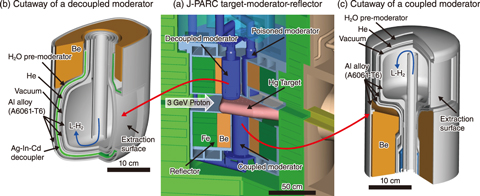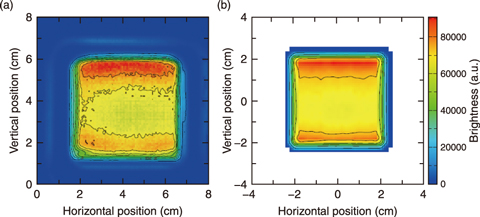
Fig.5-9 Core of high-intensity spallation neutron source

Fig.5-10 Method to measure neutron brightness on a moderator surface with pinhole collimator

Fig.5-11 Brightness distribution on a coupled moderator surface (5−10 meV)

Fig.5-12 Brightness distribution on a decoupled moderator surface (5−10 meV)
At the spallation neutron source in the J-PARC, a high-intensity pulsed proton beam induces a mercury target to provide pulsed neutron beams to neutron experiment instruments. To enhance cold neutron beams, the neutron source has beryllium-iron reflectors and liquid hydrogen moderators (Fig.5-9). The liquid moderators, operated at 20 K, are composed of a coupled moderator to provide an intense neutron beam and two decoupled moderators to provide sharp neutron beams. The decoupled moderators are surrounded by neutron absorbing materials to sharpen the pulse shapes with a sacrifice of intensity. The neutron source was designed by a particle transport simulation code to optimize the neutron pulse characteristics while retaining heat removal, structural design integrity, and radiation damage control, to pay attention to para-hydrogen characteristics as the moderator material. The pulse characteristics used by the para-hydrogen successfully demonstrated neutron brightness distribution on a moderator surface. Therefore, a measurement of the brightness on the moderators was done for a validation to the simulation. The brightness on a moderator surface was measured with a pinhole collimator, which provides an inversed image, as shown in Fig.5-10.
The measured (a) and calculated (b) neutron brightness in the energy region from 5 meV to 10 meV are shown in Figs.5-11 and 5-12 on a coupled and decoupled moderator surface, respectively. The measured and calculated results were in good agreement, and a higher intensity was seen on the coupled surface at the edge than at the center. In the decoupled surface, a higher intensity was observed at the center than that at the edge, also in good agreement with the experimental results.
Overall, the developed particle transport model and the accuracy of the designs was shown to accurately predict neutron brightness. By utilization of these knowledges, future works will aim to upgrade of the neutron source and development of a new neutron source.